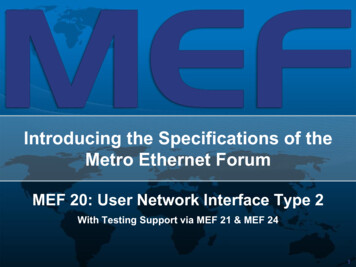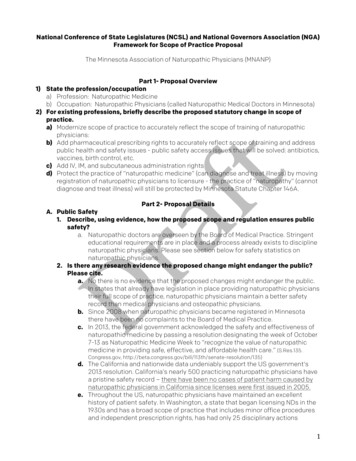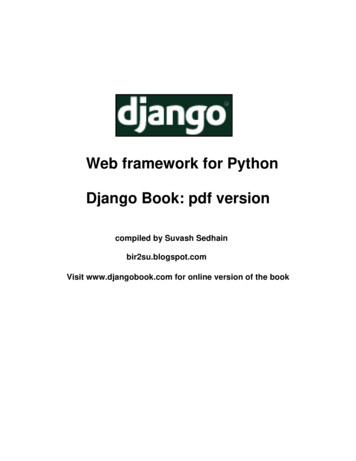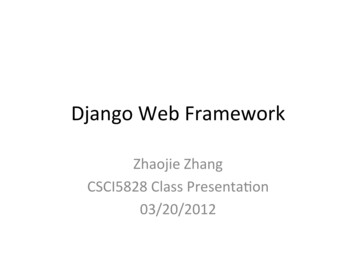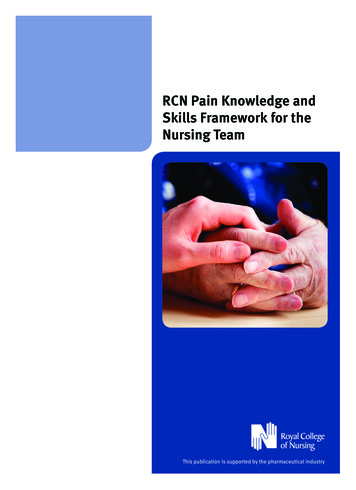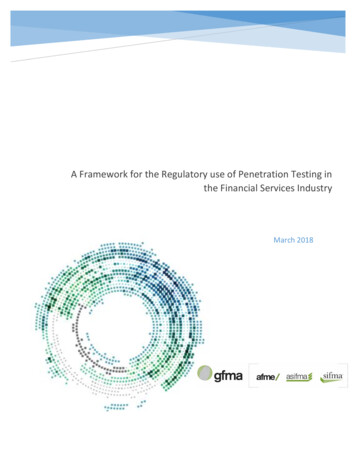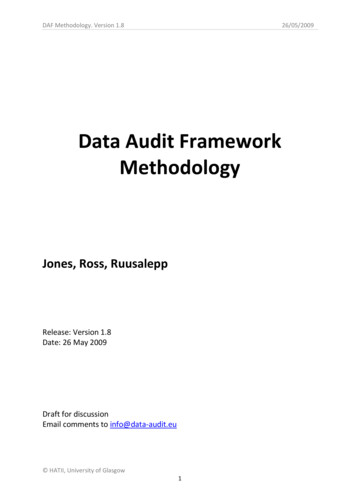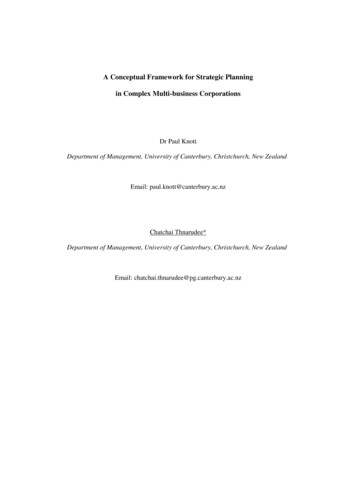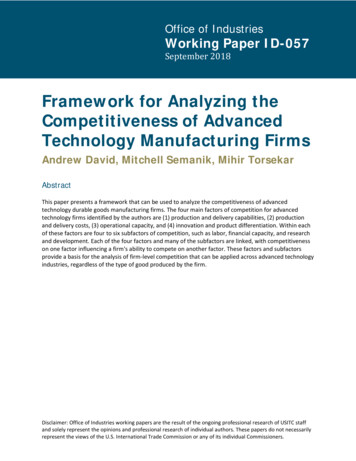
Transcription
Technical SpecificationMEF 4Metro Ethernet Network ArchitectureFramework - Part 1: Generic FrameworkMay 2004MEF 4 The Metro Ethernet Forum 2004. Any reproduction of this document, or any portion thereof, shallcontain the following statement: "Reproduced with permission of the Metro Ethernet Forum." No userof this document is authorized to modify any of the information contained herein.
DisclaimerThe information in this publication is freely available for reproduction and use by any recipientand is believed to be accurate as of its publication date. Such information is subject to changewithout notice and the Metro Ethernet Forum (MEF) is not responsible for any errors. The MEFdoes not assume responsibility to update or correct any information in this publication. Norepresentation or warranty, expressed or implied, is made by the MEF concerning thecompleteness, accuracy, or applicability of any information contained herein and no liability ofany kind shall be assumed by the MEF as a result of reliance upon such information.The information contained herein is intended to be used without modification by the recipient oruser of this document. The MEF is not responsible or liable for any modifications to thisdocument made by any other party.The receipt or any use of this document or its contents does not in any way create, by implicationor otherwise:(a) any express or implied license or right to or under any patent, copyright, trademark ortrade secret rights held or claimed by any MEF member company which are or may beassociated with the ideas, techniques, concepts or expressions contained herein; nor(b) any warranty or representation that any MEF member companies will announce anyproduct(s) and/or service(s) related thereto, or if such announcements are made, thatsuch announced product(s) and/or service(s) embody any or all of the ideas,technologies, or concepts contained herein; nor(c) any form of relationship between any MEF member companies and the recipient oruser of this document.Implementation or use of specific Metro Ethernet standards or recommendations and MEFspecifications will be voluntary, and no company shall be obliged to implement them by virtue ofparticipation in the Metro Ethernet Forum. The MEF is a non-profit international organizationaccelerating industry cooperation on Metro Ethernet technology. The MEF does not, expressly orotherwise, endorse or promote any specific products or services. The Metro Ethernet Forum 2004. All Rights Reserved.MEF 4 The Metro Ethernet Forum 2004. Any reproduction of this document, or any portion thereof, shallcontain the following statement: "Reproduced with permission of the Metro Ethernet Forum." No userof this document is authorized to modify any of the information contained herein.
Metro Ethernet Network Architecture Framework - Part 1:Generic FrameworkTable of Contents1.Abstract . 32.Terminology. 33.Scope. 44.Compliance Levels . 45.MEN Reference Model . 56.MEN Layer Network Model . 66.16.26.37.Ethernet Services Layer (ETH Layer) . 6Transport Services Layer (TRAN Layer) . 7Application Services Layer (APP Layer) . 7MEN Reference Points . 77.1User-Network Interface (UNI) . 87.1.17.1.27.27.37.47.57.6External Network-to-Network Interface (E-NNI) . 9Internal Network-to-Network Interface (I-NNI) . 10Network Interworking Network-to-Network Interface (NI-NNI) . 10Service Interworking Network-to-Network Interface (SI-NNI) . 10Other MEN Access Arrangements . 117.6.18.UNI Client (UNI-C) . 9UNI Network (UNI-N) . 9Service Node Interface (SNI) . 11MEN Architectural Components. 118.18.28.3Topological Components . 12Transport Components . 13Processing Components (The MEN Functional Elements) . 138.3.19.Generic MEN Functional Elements . 14MEN Layers Relationship to the Architecture Model Components . 159.19.29.310.Operational Planes and the MEN Layer Networks . 15MEN Network Reference Model and the Topological Components . 15MEN Reference Link Model . 17References . 19Appendix I: Generic Transport Entities and Reference Points of a Layer Network . 20MEF 4 The Metro Ethernet Forum 2004. Any reproduction of this document, or any portion thereof, shallcontain the following statement: "Reproduced with permission of the Metro Ethernet Forum." No userof this document is authorized to modify any of the information contained herein.Page i
Metro Ethernet Network Architecture Framework - Part 1:Generic FrameworkI.1I.2I. 3The Client/Server Layer Network Model . 20Adaptation & Termination Functions . 21Relationships between Connection-Oriented vs. Connectionless Components . 23Appendix II: MEN Physical Components . 25II.1 Customer Edge (CE) Equipment . 25II.2 Provider Edge (PE) Equipment . 25II.3 Provider (P) Core Equipment. 25II.4 Network Termination (NT) Equipment . 26II.5 Transport Edge (TE) Equipment . 26List of FiguresFigure 1: Basic Network Reference Model . 5Figure 2: MEN Layer Network Model . 6Figure 3: MEN External Interfaces and associated reference points. 8Figure 4: The UNI and the MEN Reference Model . 9Figure 5: Reference points for access arrangements into a MEN via an SNI. 11Figure 6: Sample relationship between MEN Reference Model and the ArchitecturalComponents . 16Figure 7: Sample decomposition of a MEN into layer networks and protocol stacks . 17Figure 8: MEN Reference Link Model (Example) . 18List of TablesTable I-1: Components of connection oriented and connectionless architectures . 24MEF 4 The Metro Ethernet Forum 2004. Any reproduction of this document, or any portion thereof, shallcontain the following statement: "Reproduced with permission of the Metro Ethernet Forum." No userof this document is authorized to modify any of the information contained herein.Page ii
Metro Ethernet Network Architecture Framework - Part 1:Generic Framework1.AbstractThis document provides the Metro Ethernet Forum (MEF) generic architectural framework forMetro Ethernet Networks (MEN). The generic architecture framework describes the high-levelconstructs used to model the various architectural components of a MEN’s Ethernet services,transport services and application services layer networks. The MEF architecture model is basedon the principle of layer network decomposition, where each layer network is constructed from aparticular set of networking technologies (e.g., Ethernet, SONET/SDH, MPLS, etc.). The modelreuses the native Ethernet frame structure [2][3] and the architectural constructs created todescribe connection and connection-less oriented transport networks in ITU-T RecommendationsG.805 [4] and G.809 EEIWFITUL1L2L2 LANMACMEFMENMPLSNENINNIMEF 4DefinitionApplication Services LayerAsynchronous Transfer ModeCustomer EdgeCharacteristic InformationEthernet Services DefinitionEthernet Services ModelEthernet Services LayerEthernet Virtual ConnectionFunctional ElementGigabit EthernetInstitute of Electrical and Electronics EngineersInterworking FunctionInternational Telecommunication UnionLayer OneLayer TwoLayer(s) above L2Local Area NetworkMedia Access ControlMetro Ethernet ForumMetro Ethernet NetworkMulti Protocol Label SwitchingNetwork ElementNetwork Interworking (e.g., NI-NNI)Network-to-Network Interface The Metro Ethernet Forum 2004. Any reproduction of this document, or any portion thereof, shallcontain the following statement: "Reproduced with permission of the Metro Ethernet Forum." No userof this document is authorized to modify any of the information contained herein.Page 3
Metro Ethernet Network Architecture Framework - Part 1:Generic ANWAN3.DefinitionNetwork TerminationOptical Transport NetworkPlesiochronous Digital HierarchyProvider EdgeResilient Packet RingSynchronous Digital HierarchyService Interworking (e.g., SI-NNI)Service Node InterfaceSynchronous Optical NetworkTransport EquipmentTransport Services LayerUser to Network InterfaceVirtual LANWide Area NetworkScopeThe architecture framework provides the generic model used by the MEF to describe internal andexternal architectural components of a MEN. The document is intended to describe the layernetwork decomposition model for a MEN in terms of a) Ethernet services, transport services andapplication services layer networks components, and b) the generic architectural componentsassociated with layer networks. The framework is also intended to describe the interactionsamong MEN architectural components across well-defined interfaces and their associatedreference points. The architecture framework is not intended to require, or exclude, any specificnetworking technology from being used on any given implementation of a MEN. Yet, thegeneric architecture framework provides the common guidelines for the specification anddecomposition of the MEN Ethernet transport and services capabilities. Detailed TechnicalSpecifications and Implementation Agreements for specific architectural elements are outside thescope of this document.4.Compliance LevelsThe key words "MUST", "MUST NOT", "REQUIRED", "SHALL", "SHALL NOT","SHOULD", "SHOULD NOT", "RECOMMENDED", "MAY", and "OPTIONAL" in thisdocument are to be interpreted as described in RFC 2119. All key words must be use upper case,bold text.MEF 4 The Metro Ethernet Forum 2004. Any reproduction of this document, or any portion thereof, shallcontain the following statement: "Reproduced with permission of the Metro Ethernet Forum." No userof this document is authorized to modify any of the information contained herein.Page 4
Metro Ethernet Network Architecture Framework - Part 1:Generic Framework5.MEN Reference ModelThe basic network reference model of a MEN is depicted in Figure 1. Two major functionalcomponents are involved:i) the subscriber/customer edge equipment, andii) the public MEN transport vateCustomerNetworkEnduserSEthernet Virtual ConnectionEnd-to-End Ethernet flowFigure 1: Basic Network Reference ModelReference point T, also referred to as the UNI reference point, demarcates the boundariesbetween the public MEN and a private customer network. Reference point S is the conceptualpoint that demarcates the boundaries between the private customer network equipment, whenpresent, and the end-user termina
This document provides the Metro Ethernet Forum (MEF) generic architectural framework for Metro Ethernet Networks (MEN). The generic architecture framework describes the high-level
